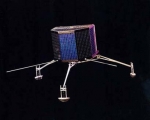Displaying items by tag: comet
Philae lander
Philae is a robotic European Space Agency lander that accompanies its Rosetta spacecraft. It is designed to land on Comet 67P/Churyumov-Gerasimenko shortly after arrival in 2014. The lander is named after Philae island in the Nile, where an obelisk was found that was used along with the Rosetta Stone to decipher Egyptian hieroglyphic.
Just as the Philae(*) Obelisk and the Rosetta Stone provided the keys to an ancient civilisation, the Philae lander and the Rosetta orbiter aim to unlock the mysteries of the oldest building blocks of our Solar System - comets.
(*) Philae is the island in the river Nile on which an obelisk was found that had a bilingual inscription including the names of Cleopatra and Ptolemy in Egyptian hieroglyphs. This provided the French historian Jean-François Champollion with the final clues that enabled him to decipher the hieroglyphs of the Rosetta Stone and unlock the secrets of the civilisation of ancient Egypt.
Rosetta spacecraft
Rosetta is a robotic spacecraft of the European Space Agency on a mission to study the comet 67P/Churyumov–Gerasimenko. Rosetta consists of two main elements:
- the Rosetta space probe;
- the Philae lander.
The spacecraft was launched on 2 March 2004 on an Ariane 5 rocket and will reach the comet by mid 2014. The space probe is intended to orbit and perform long-term exploration of the comet at close quarters. On 10 November 2014 the Philae lander will attempt to land and perform detailed investigations on the comet's surface. Both the probe and the lander carry a large complement of scientific experiments designed to complete the most detailed study of a comet ever attempted.
The probe is named after the Rosetta Stone, as it is hoped the mission will help form an idea of how the solar system looked before planets formed. The lander is named after the Nile island Philae where an obelisk was found that helped decipher the Rosetta Stone. The spacecraft has already performed two successful asteroid flyby missions on its way to the comet. In 2007 performed a Mars swingby (flyby), and returned images. The craft completed its fly-by of asteroid 2867 Šteins in September 2008 and of 21 Lutetia in July 2010, and is presently (2013) in hibernation and on-target for its final destination as of June 2013.


